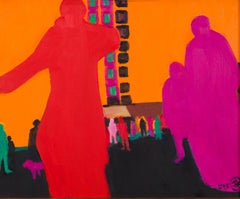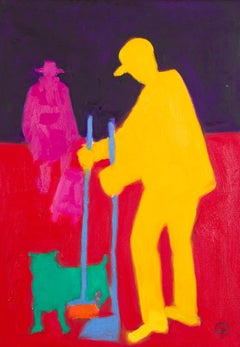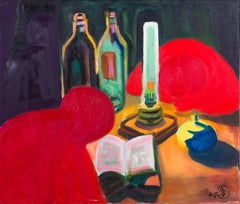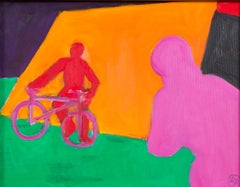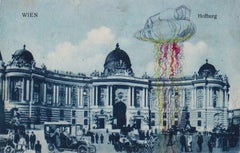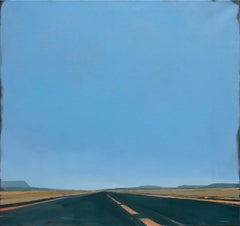Galerie Lehner Paintings
to
20
35
40
21
23
Overall Width
to
Overall Height
to
1
81
57
3
6
2
3
3
10
2
9
51
44
13
4
2
75
54
9
67
39
37
22
19
14
11
10
10
9
8
7
6
6
5
5
5
4
4
4
129
106
94
92
22
7
6
5
5
4
16
58
139
Klage (Die orangene Stadt)
By Robert Hammerstiel
Located in Wien, 9
In his painting, Robert Hammerstiel is in constant search of the balance and harmony of form. In his drastic reduction to the physical essentials and the colourful placarding, he cre...
Category
21st Century and Contemporary Contemporary Abstract Paintings
Materials
Canvas, Oil
Der Hundemann
By Robert Hammerstiel
Located in Wien, 9
In his painting, Robert Hammerstiel is in constant search of the balance and harmony of form. In his drastic reduction to the physical essentials and the colourful placarding, he cre...
Category
21st Century and Contemporary Contemporary Abstract Paintings
Materials
Canvas, Oil
Blockade Stillleben (Hommage à Karl Schmidt Rottluff)
By Robert Hammerstiel
Located in Wien, 9
In his painting, Robert Hammerstiel is in constant search of the balance and harmony of form. In his drastic reduction to the physical essentials and the colourful placarding, he cre...
Category
21st Century and Contemporary Contemporary Abstract Paintings
Materials
Canvas, Oil
Begegnung
By Robert Hammerstiel
Located in Wien, 9
In his painting, Robert Hammerstiel is in constant search of the balance and harmony of form. In his drastic reduction to the physical essentials and the colourful placarding, he cre...
Category
21st Century and Contemporary Contemporary Abstract Paintings
Materials
Canvas, Oil
Portugese man o´war
Located in Wien, 9
Xenia Ostrovskaya's work explores ideas of heritage and belonging by juxtaposing the Anthropocene world and its memorabilia with sculptural representations of flora and fauna. The no...
Category
2010s Contemporary Animal Paintings
Materials
Acrylic
Adentrarse en el Desierto
By Eduardo Roca
Located in Wien, 9
Since the beginning of his career, Roca has moved with a high level of technical skill, a feel for light and color in the – at first glance – classic genres of landscape, still life ...
Category
2010s Landscape Paintings
Materials
Canvas, Oil
Blumenkrug / Flower Jug
By Helmut Verch
Located in Wien, 9
Helmut Verch (1923-2002) was born in Berlin in 1923 and worked as a painter and graphic artist. In the 1940s, after his release from Russian captivity, he received artistic training ...
Category
1990s Modern Figurative Paintings
Materials
Canvas, Oil
Dächer und Türme / Roofs and Towers
By Helmut Verch
Located in Wien, 9
Helmut Verch (1923-2002) was born in Berlin in 1923 and worked as a painter and graphic artist. In the 1940s, after his release from Russian captivity, he received artistic training ...
Category
1970s Cubist Figurative Paintings
Materials
Canvas, Oil
Sitting girl with open book
Located in Wien, 9
As a pupil of William Straube, Dora Hitz, Max Pechstein and Willy Jaeckel, Edith Meyer von Kamptz achieved her own individual aesthetic designs with colourfu...
Category
1930s Modern Portrait Paintings
Materials
Canvas, Oil
Ohne Titel
Located in Wien, 9
Margarethe Hollegha is a Postwar & Contemporary artist who was born in 1935 in Vienna.
The picture is framed with a gilded flat moulding.
Category
Early 2000s Contemporary Figurative Paintings
Materials
Canvas, Mixed Media
Selbstporträt / Selfportrait
Located in Wien, 9
Julius Zimpel
* 30.8.1896 Vienna, † 11.8.1925 Vienna
"First artistic inspiration by his uncle Gustav Klimt. 1911-16 attended the School of Arts and Crafts under F. Cizek, A. v. Ken...
Category
20th Century Modern Portrait Paintings
Materials
Canvas, Oil
Häuser in einer Landschaft
Located in Wien, 9
In expressionist style, a house surrounded by trees and bushes is shown. The reduction to the essential reinforces the impression of the anonymous village. Henri Schäfer...
Category
20th Century Abstract Expressionist Landscape Paintings
Materials
Canvas, Oil
Prozession
Located in Wien, 9
Grete Copony attended various art schools in Germany, such as with Moritz Heymann in Munich and the drawing and painting school of the Association of Berlin Women Artists, and the Budapest Art...
Category
20th Century Modern Figurative Paintings
Materials
Oil, Panel
$14,950
CL45
Located in Wien, 9
Mikesch, who had lived in Berlin as a freelancer since 1966, was originally active as a painter and graphic artist. He worked for radio from 1979. He wrote prose texts for children a...
Category
1970s Contemporary Figurative Paintings
Materials
Acrylic, Canvas
$3,684
Klare Sicht / Clear View
Located in Wien, 9
Mikesch, who had lived in Berlin as a freelancer since 1966, was originally active as a painter and graphic artist. He worked for radio from 1979. He wrote prose texts for children a...
Category
1970s Contemporary Figurative Paintings
Materials
Acrylic, Panel
Ischia II
By Hans Franta
Located in Wien, 9
If you compare Hans Franta’s earliest works – from around 1911 to 1920 – with his later work from the years after the Second World War, the fact becomes obvious that you are dealing ...
Category
20th Century Modern Abstract Paintings
Materials
Pastel
$1,578
Message in the Morning
By Robert Hammerstiel
Located in Wien, 9
In his painting, Robert Hammerstiel is in constant search of the balance and harmony of form. In his drastic reduction to the physical essentials and the colourful placarding, he cre...
Category
21st Century and Contemporary Contemporary Abstract Paintings
Materials
Canvas, Acrylic
The yellow separation
By Robert Hammerstiel
Located in Wien, 9
In his painting, Robert Hammerstiel is in constant search of the balance and harmony of form. In his drastic reduction to the physical essentials and the colourful placarding, he cre...
Category
Early 2000s Contemporary Figurative Paintings
Materials
Canvas, Oil
Wooden Heads
Located in Wien, 9
Since Franz Ecker’s early death in 1999 his work has been newly appreciated, what is manifested in numerous exhibitions, catalogues and in the acclaimed film about the artist. He was extremely productive and left behind an almost unmanageable scope of works in various styles. Among them some of the top works that are unparalleled in recent Austrian art history and whose significance has not yet been adequately appreciated.
After finishing his studies in 1966 in class of prof. Sergius Pauser and after receiving his two prizes, Franz Ecker moved back to Leonding where he developed his clear, abstract language of forms. Among his sources of inspiration are Cezanne and Picasso, as well as Martin Polasek who was one of his teachers. This led him to painting in a flat and abstract manner, which triggers a spatial experience through its exact color coordination and strict composition. The strongest period in his oeuvre is the time when his paintings are between figuration and abstraction. Only until around 1975 he additionally creates numerous watercolors, even though he restricts this medium to his more lyrical works.
If Franz Ecker cannot be included in the avant-garde cannon of the 70’s, it is only because he witheld from presenting his works on the art market. Instead of using the opportunities that were offered to him in Vienna, he returned after his time at the academy to Linz where there was no appreciation nor market for his works. Distanced from the established art business, Ecker lives uncompromisingly the precarious life of a lonely genius. An artist myth, which in his case certainly is a bitter reality. Unimpressed by this, Ecker develops an increasingly broad language of forms within the clear line of abstract pictorial conception, which he emphasizes with constantly new forms of signature.
At the end of the seventies his works became more gestural and expressive. His works like “Kafka” anticipate the “Neue Wilden”. When these are celebrated as the “return of painting...
Category
Late 20th Century Abstract Abstract Paintings
Materials
Paint, Oil, Panel, Wood Panel
$4,737
